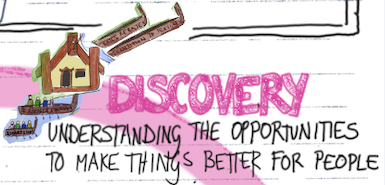Indepth work focused on research and designing responses
Discovery phase
In brief
- Research discovery - focuses on in-depth research into the subject matter. It is particularly important to help better understand complex issues such as a ‘Life Event’.
- Design discovery - typically follows research discovery and focuses on creating and developing prototypes and concepts. These may be new products / services / approaches or adapted versions of ideas identified through the ‘Research Discovery’ phase.
Research discovery
A research discovery is a substantial piece of research investigation and evidencing. It is applicable to complex issues that fall within but are not limited to, a ‘Life Event’.
- Action: in-depth research into the subject matter. Capability uplift of an external team (where applicable), co-design, collaboration and outreach. Embed evidential design rigor, apply quantitative and qualitative research and evidencing.
- Deliverable: A research discovery document with findings and next steps actions. Reports of all the evidence and findings. Suggestion on areas to develop further through a Design Discovery.
- Outcome: At the end of this discovery. Time will be taken to drawn up a ‘Project Roadmap’. The roadmap builds on the project scope document and details all the operational requirements to meet the outcomes defined and agreed in from the research discovery.
Design discovery
A Design Discovery focuses developing and testing possible solutions. It addresses the feasibility, capability and usability of a testable product or service. It can be a standalone product / service or a product / service that has emerged from work undertaken in the Research Discovery phase.
A Design Discovery has four distinct stages:
1 - Design scope 2 - Problem Definition 3 - Problem Validation 4 - Solution Validation
For a product / service to be designed and built within the Lab it must pass through the four design stages. A stage-gate acts a failsafe at the end of each stage where a design is assessed before further progress is committed to. User experience design and research testing is extensively required at each point. Action:
- Design scope - Suggested concepts are scoped for design feasibility
- Problem Definition - An evidenced problem is defined that can be designed for
- Problem Validation - Is the design problem meeting the wider project needs?
- Solution Validation - what are the design solutions, use testing to validate them
Deliverables:
- Design scope - A design brief for the design team to work from
- Problem Definition - Design Problem or Problem Statements
- Problem Validation - Evidencing of the design approach to meet the problem space (UX research)
- Solution Validation - Lo-fi testing and validation of the solutions proposed (UX)
Outcome: On conclusion of a Design Discovery a clear design approach has been formulated and a prototype can be green lite to proceed.
Features
- Focus on quantitative and qualitative research
- Co-led by lab team with partners
- Opportunity for capability uplift for agency teams in design research methods
- Specialist external expertise may be needed
- Recognition that some research will be evidence based
- Refined design scope and problem definition to help guide ideation work
Activities / outputs
- Desktop research and data analysis
- User research / ethnography
- SME interviews
- Case studies and site visits
- Scoping and problem definition reports
- Ideation workshops
- Developing concepts, prototypes leading to a Minimum Viable Product (MVP)
- Options / recommendations report
Key lab team reflections for this phase
Research discovery doesn’t mean starting from first base
- Explore and build on existing research and evidence
- People may have told their story already - don’t assume fresh user research is the best starting point
- How well does your research team relfect the population groups you’re working with?
- Practice based evidence can be just as valuable as evidence based practice
- Lean against the problem - avoid the trap of rushing to solutionize too soon
- Take time to understand the problem and the system that holds it
Design discovery work can include new and existing ideas
- How will users be involved in the design discovery work? If not, why not?
- Don’t discount adopting and adapting ideas from elsewhere - creative responses don’t always need to be new
- How might ideas from the discovery phase leverage existing work
- If the work is likely to involved developers try to involved them during the design phase
- Design discovery (building to learn with users) can deliver as much useful insight as the research phase
Keep people engage in the deep work
- Tell the story of the work as you go - share your successes and when things don’t go right
- Share emerging learning with sponsors and wider groups of people involved in the work
- Close the loop and seek feedback from the people involved in discovery phase - make it reciprocal


